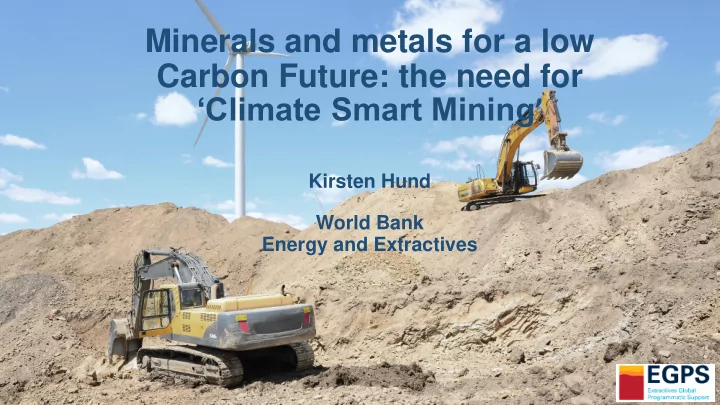

Minerals and metals for a low Carbon Future: the need for ‘Climate Smart Mining ’ Kirsten Hund World Bank Energy and Extractives
Presentation outline 01 02 03 04 1. Why a low- 2. What does this 3. The need for ‘ 4. Way forward carbon future will mean for resource- climate smart’ be more mineral rich countries and mining intensive producer companies
Without metals there would simply be no low carbon 3 future possible … One 3-MW turbine contains 2 tons of rare earth elements. 335 tons of steel. zinc 4.7 tons of copper. molybdenum 1,200 tons of concrete (cement and aggregates) Source: (NW Mining Association) 3 tons of aluminum.
4 Electric hybrid cars use twice as much copper as non-hybrid cars
The Growing Role of Minerals for a 5 Low carbon future Examines the implications of changing material requirements for the mining/metals industry as a result of low carbon energy future. How can resource rich developing countries best position themselves to take advantage of the evolving commodities market ?
IEA’s ETP 2016 Scenarios 6 IEA’s Energy Technology Perspective Scenarios For Electricity Installed Capacity 6 degree scenario 4 degree scenario 2 degree scenario 16,000 Hydro (excl. pumped storage) Coal Hydro (excl. pumped storage) Coal Hydro (excl. pumped storage) Coal Natural Gas Oil Natural Gas Oil Natural Gas Oil 14,000 Nuclear Wind Nuclear Wind Nuclear Wind Electricity Installed Capacity (GW) Solar Biomass Solar Biomass Solar Biomass 12,000 Geothermal Ocean Geothermal Ocean Geothermal Ocean 10,000 8,000 6,000 4,000 2,000 0 2013 2020 2030 2040 2050 2013 2020 2030 2040 2050 2013 2020 2030 2040 2050 Source: IEA ETP 2016
7 Technology Studied Onshore Wind Offshore Photovoltaics – crystalline silicon Photovoltaics – CdTe Solar Photovoltaics – CIGS PV – amorphous silicon CSP (split between li- Energy Storage ion, lead-acid, Automotive other) Grid-scale Decentralise
Example: Change in metal demand from Solar PV 9 (as percentage change from 6 degree scenario) Source: WB Analysis Note: Values are derived from mean value of ‘metal per MW’ demand
Example: Change in metal demand from Energy Battery 11 Storage (as percentage change from 6 degree scenario)
2. . Where will th these resources come fr from? 12
Example: Mapping Critical metals: 1: Bauxite/ 13 Aluminum Bauxite Production and Reserves for 2015 (Thousand Metric Tons) Mine Production Reserves AUSTRALIA 80,000 6,200,000 CHINA 60,000 830,000 MALAYSIA 21,200 40,000 INDIA 19,200 590,000 GUINEA 17,700 7,400,000 JAMAICA 10,700 2,000,000 GREECE 6,600 250,000 RUSSIA 6,600 200,000 KAZAKHSTAN 5,200 160,000 SURINAME 2,200 580,000 BRAZIL 2,000 2,600,000 GUYANA 1,700 850,000 VENEZUELA 1,500 320,000 VIETNAM 1,100 2,100,000 INDONESIA 1,000 1,000,000 USA N/A 20,000 Developing Countries % of Bauxite Production OTHER COUNTRIES 8,500 2,400,000 represents 52%, without China, 30%. TOTAL 274,000 28,000,000 Developing Countries % of Bauxite Reserves represents 65%, without China 63%.
15 Mapping Critical metals: 3: Lithium Lithium Production and Reserves for 2015(Metric tons) Production Reserves AUSTRALIA 13,400 1,500,000 CHILE 11,700 7,500,000 ARGENTINA 3,800 2,000,000 CHINA 2,200 3,200,000 ZIMBABWE 900 23,000 PORTUGAL 300 60,000 BRAZIL 160 48,000 USA N/A N/A TOTAL ~ 32,500 ~ 14,000,000 Developing countries % of lithium production 52%, without China 45% Developing countries % of lithium reserves 91%, without China 68%
3. . Addressing the carbon footprint of the industry 16
Low-emission technologies: In Innovation and efficiency • New modes of extraction practices • Energy and water efficiency • Methane emission reduction opportunities • Use of smart data • Carbon Capture and Storage • Mostly Industry-led: role for governments? 17
In Integrated Landsc scape Management and pla lannin ing - in inclu ludin ing in infr frastructure • 20% of all GHG emissions come from Deforestation • Grades diminish, deforestation increases • Footprint of associated Infrastructure • Spatial Planning/ resource Corridors Challenge: Requires a leading role from government and intergovernmental coordination 18
4. Conclusions: Towards a ‘Climate Smart’ Mineral and Metals Industry? • Meeting the Paris climate target will require a radical restructuring of energy supply and transmission systems globally; • The clean energy shift will be significantly MORE material intensive • This will probably open up new mining frontiers with new opportunities and risks • Technology choices matter: Need for a flexible approach • Footprint implications of the materiality of clean energy need to be factored into climate change and mineral development strategies of countries and companies Need for a multi stakeholder approach: Governments, industry, Mining and Metals Community, Climate Change/ Sustainable Development Community
21 Thank you! Khund@worldbank.org full report: http://www.worldbank.org/en/topic/energy/publication/minerals-and-metals-to-play- significant-role-in-a-low-carbon-future
Recommend
More recommend